Hedgerows in the parish of Overton
Hedgerows are one of the most characteristic features of the British countryside. Of great importance visually, culturally and historically, they provide a rich habitat for many of our native species of plants and animals. In 2003 the O.B.S. estimated that the total length of hedgerows in the parish was 150 km and their density approximately 4 km/km2 (view map).
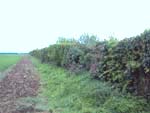
With the help of volunteers, in 2003 and 2004 the O.B.S. carried out survey of local hedgerows according to the protocol developed by the Steering Group for the UK Biodiversity Action Plan for Ancient and/or Species-rich Hedgerows (handbook available from English Nature). In total 77 hedgerows were surveyed throughout the parish of Overton.
Physical characteristics
 Most hedgerows surveyed were well established, 1 to 4 meters wide and over 2 meters high. One third of hedgerows were stockproof, one third had minor gaps and one third was leggy and/or had significant gaps. Most hedgerows (60%) showed signed of recent management (usually flailing or trimming) and those with no sign of recent management were relatively more 'gappy' and leggy (click chart to enlarge).
Most hedgerows surveyed were well established, 1 to 4 meters wide and over 2 meters high. One third of hedgerows were stockproof, one third had minor gaps and one third was leggy and/or had significant gaps. Most hedgerows (60%) showed signed of recent management (usually flailing or trimming) and those with no sign of recent management were relatively more 'gappy' and leggy (click chart to enlarge).
Hedgerow trees
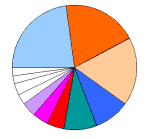 The number of trees per hedgerows varied widely: approximately 1/4 of the hedges sampled contained no trees, 1/4 contained 1-5 trees and 1/2 contained more than 5 trees. Altogether 147 trees were sampled (in 35 hedge samples), belonging to 21 species in the proportions indicated in the pie chart (click chart to enlarge). The most abundant species were ash, sycamore and common oak.
The number of trees per hedgerows varied widely: approximately 1/4 of the hedges sampled contained no trees, 1/4 contained 1-5 trees and 1/2 contained more than 5 trees. Altogether 147 trees were sampled (in 35 hedge samples), belonging to 21 species in the proportions indicated in the pie chart (click chart to enlarge). The most abundant species were ash, sycamore and common oak.

Shrub layer
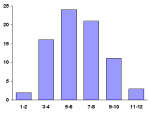
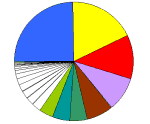 79% of the hedges sampled contained five or more woody species and thus may be qualified as species-rich (click bar graph to enlarge). Altogether, 34 woody species and 6 non-woody climbers were recorded in the shrub layer of the 77 hedge samples. The most abundant species was hawthorn, covering on average 26% of the length of hedgerows surveyed. Blackthorn and hazel were the next two most abundant species (click pie chart to enlarge).
79% of the hedges sampled contained five or more woody species and thus may be qualified as species-rich (click bar graph to enlarge). Altogether, 34 woody species and 6 non-woody climbers were recorded in the shrub layer of the 77 hedge samples. The most abundant species was hawthorn, covering on average 26% of the length of hedgerows surveyed. Blackthorn and hazel were the next two most abundant species (click pie chart to enlarge).
Old man's beard was found in 40% of hedgerows and covered on average 9% of the length of hedgerows surveyed. Other non-woody climbers were quite rare.
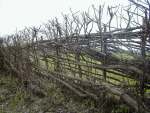

Ground flora
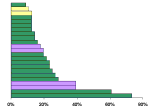 On average 14 species were found growing at the foot of hedgerows surveyed: 7 herbaceous species, 2 grass species and 5 woody species. Overall 94 herbaceous species, 13 grass species, 13 woody species and 1 fern species (Rusty-back fern, Ceterach officinarum) were identified. The most frequently encountered species were nettle and cleavers (click on the chart for all species frequency).
On average 14 species were found growing at the foot of hedgerows surveyed: 7 herbaceous species, 2 grass species and 5 woody species. Overall 94 herbaceous species, 13 grass species, 13 woody species and 1 fern species (Rusty-back fern, Ceterach officinarum) were identified. The most frequently encountered species were nettle and cleavers (click on the chart for all species frequency).
Conclusion
This project has been extremely successful in that it has generated a lot of interest and involvement within the local community. In 2 years a wealth of information has been gathered and we now have a clearer picture of our local hedgerows. In most respects this picture is very representative of hedgerows in the chalky arable landscape of Southern England, although interestingly, our hedgerows appeared to be more species-rich than the national average.
A preliminary report and the final report with the complete results of this hedgerow survey are available to download from our online library in the 'resources' section of this web site. In addition, we have produced a booklet including a summary of the results and additional information on the history of hedgerows, hedgerows and the law, hedgerow planting and management, shrub identification... available for purchase from the O.B.S. (£2) and also available to download from the online library.
